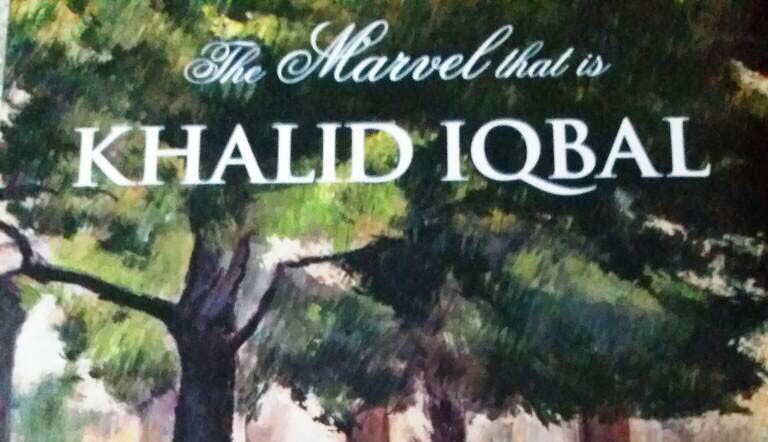
A book exploring the artist’s personality, education, and influences and some of his most distinct paintings

Khalid Iqbal was a leading painter of the country. He dedicated all his life to this pursuit and left much else to be unequivocal about it. The long years that he spent in Punjab were devoted to capturing the various hues, colours and contours of the landscape that he seemed to love so much.
Munawar Ahmad knew the man from very early years. Though a medical doctor by profession, Ahmad, too, loved the various aspects of the arts and despite limited time due to his profession, indulged in a few of them in a manner which can be called more than mere dabbling.
He loved to play the sitar, also painted and it was primarily landscape that he preferred as his subject. The love and penchant for landscape could have been because of his association with Iqbal or it could be that the love for the commonality of subject brought him close to Iqbal. They developed a close bond and it is apparent from the book that they spent a lot of time together. It was an association that went further than the ambit of an artist and his admirer.
The book is divided into two sections -- the first deals with the person, his education, influences, and temperament while the second is about some of his most distinct paintings.
Khalid Iqbal was born in Dehradun and went to St Joseph‘s Academy but then the family moved to Lahore because there were no institutions of higher learning there. Iqbal joined the famous Forman Christian College in Lahore. The Fine Arts Department of the Punjab University was only meant for female students, it opened its door to male students only in 1956. So, Iqbal started attending classes at the Mayo School and it was there that he met his major inspiration, Sheikh Ahmed.
After graduating from Forman Christian College, Iqbal in 1949 joined the Aitchison College, Lahore as an art teacher from 1949 to 1952. But he wanted to know and learn more and was keen to get foreign education. So, from 1952 to 1955, Iqbal joined the Slade School, the most prestigious school of visual arts in the world.
The principal of the School, William Coldstream, a realist painter committed to painting directly from life and in the habit of using layers of paint thinned with turpentine oil, impressed Iqbal immensely. He was directly influenced by Coldstream in the use of thinned layers of paint.
The teaching revolved round simple lead pencil drawing on white paper and this greatly helped Iqbal’s ability to draw, which in any case was his forte. There was a great deal of freedom in the institution and frequent debates were held about art and the various movements. Khalid Iqbal took part in the debates and was hugely appreciated by his tutors.
At the time, the Victorian romantic tradition found its way into Indian artistic pursuits, introducing new materials, such as oil paint and canvasses for painting landscape, portraits as well as perspective, chiaroscuro and handling of oil colours.
In India, schools of industrial arts were established on the pattern of School of Industrial Arts in South Kensington, London. It was also followed by growth of art exhibitions, art journalism, and subsequently an art conscious public.
The contribution of Khalid Iqbal can only be properly assessed if seen within the context of the tradition and developments taking place in paintings in the Indian subcontinent. A native cultural wave was initiated by Rabindranath Tagore and his nephew Abanindranath Tagore. The latter followed the delicate skills of the Mughal masters but eventually discarded it for light brush strokes and delicate lines of the Japanese art. To all this he added the wash technique.
A little later, Abdur Rahman Chughtai, representing the awakening of Muslim political and cultural identity again in response to growing awareness about Indian nationalism, drew inspiration from Mughal miniatures, European Art Nouveau, and wash technique of the Bengal School. Ustad Allah Bukhsh excelled in figurative art and painted Punjab legendary romantic characters. He also painted the landscape.
After teaching at the Punjab University, Iqbal joined the National College of Arts for the next fifteen years till 1980. He was a realistic painter and advised his students to go to the countryside and paint from life to develop the feel of the place. He liked to work on hardboard and blended cold rational observation with warm humane interpretation.
The dramatisation in his work was limited to what was to the point, significant, and decisive that gradually unfolded in detail with the finer aspects pointed out and the distinctive aspects of style highlighted. For a painter espousing realism, it is perhaps more difficult to pick and choose, what to leave out and what to include in the frame or the canvass. In the end, it all looks realistic but what the painter has left out and not included has as much significance as what has been included.
The landscapes are thus rarefied versions of what one sees and it is the painter who allows the viewer to focus on what has been included in the painting. The portraits of Khalid Iqbal -- of ordinary people of the Punjab -- are also very telling and expose the angle from where he looked at and viewed society. Beautifully reproduced, the book includes his representative work.
He was foremost a painter and secondly a teacher. Administrative jobs he really had no penchant for.
At times it so happened that he was asked by government officials to take over the principalship of the National College of Arts but he flatly refused. Correspondence to this effect has been included in the book because it is rare in Pakistan that people refuse positions of authority and power but Khalid Iqbal was such a person.
He lived quietly, happy painting and mingling with his growing body of students, some of whom became painters of repute themselves.